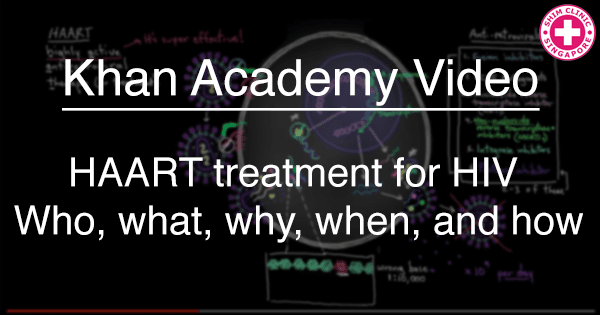Introduction
This video provides a great introduction to HAART. Highly Active Anti-Retroviral Treatment (or HAART) is a very effective and novel treatment for treating HIV. Early HIV treatment regimens often comprise of a single drug but this has proven to be rather challenging as the virus mutates very often thus allowing it to become resistant to the drug being used. Post-mutation the infection resumes and the patient’s condition may worsen after only a brief period of improvement. In this situation, HAART is highly effective, as it offers a combination of 2 or 3 drugs which controls the infection very efficiently. Every drug used in the HAART regimen has a different mechanism and affects a different point in the life cycle of the HIV virus.
In this situation, HAART is highly effective, as it offers a combination of 2 or 3 drugs which controls the infection very efficiently. Every drug used in the HAART regimen has a different mechanism and affects a different point in the life cycle of the HIV virus. Thus, when used together, the life cycle of the virus is checked at different points. So in case one drug fails, there will be more to control the replication as well as propagation of the virus. In addition, using multiple drugs minimizes the instances of drug resistance. If the virus becomes resistance to one of the drugs in the regimen, the regimen is still effective. There is a very bleak chance (about 1 in a trillion) that the virus will develop resistance to the particular mixture of drugs used in that particular regimen.
Mutations in HIV
During the process of replication, an enzyme called reverse transcriptase codes for the DNA which will belong to the new viral particles being formed. In the process, it makes a number of mistakes (1 in every 10000 base pairs). Such mistakes in the DNA lead to mutations. The mutations are quite persistent as the HIV virus does not have a very effective DNA repair system. The speaker in the video uses the example of Integrase to explain the situation. If there is a mutation in the part of the DNA encoding for the Integrase enzyme, the enzyme might still be functional but the integrase inhibitor used in the HAART regimen may not be effective in blocking it anymore. Thus, this drug becomes ineffective. However since this regimen also contains other drugs which would halt the replication at other points, the regimen as a whole could still be effective.
Who, When and How
Although it seems logical that everyone infected by HIV should immediately go to their nearest STD clinic and request for a HAART regimen, it is not very practical as there are certain negative sides to starting therapy too early. A major negative aspect is the possibility of severe side effects to the drugs like increased risks of strokes and heart attacks, loss of bone density with age, psychiatric side effects, chronic diarrhoea etc. Another drawback is that the regimen requires strict adherence. Once started they have to be followed all through the lives of the patients. Several studies have already demonstrated that not following the regimen strictly only makes matters worse for the patients. Not only is the virus revived when the regimen is discontinued, but also the virus becomes stronger when the immune system of the person becomes weaker. Adhering to the regimen has become less complex after the introduction of single pill HAART drug cocktails. They have not only made things much easier but also motivated more people to stick to the regimen.
The right time to begin the treatment is subjective and changes from person to person. Generally the CD40 cell count is considered in the decision making. If the CD40 cell count is less than 350-500 cells per cubic cm of blood, then it’s a good time to start the HAART treatment. In addition, certain situations like the pregnancy of the infected, or if the infected person is a young adult etc., immediate application of HAART treatment is necessary.
This video is prepared in the form of a lecture by Khan Academy and is a great introduction to helping the public to learn about the HAART treatment.

